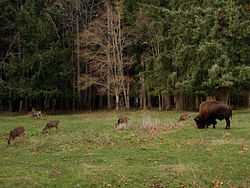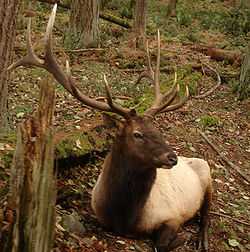Northwest Trek
|
Male (bull) Roosevelt elk as seen on Tram Tour | |
| Date opened | 1975[1] |
|---|---|
| Location | near Eatonville, Washington, USA |
| Coordinates | 46°54′58″N 122°16′19″W / 46.9161515°N 122.2718239°WCoordinates: 46°54′58″N 122°16′19″W / 46.9161515°N 122.2718239°W |
| Land area | 723 acres (293 ha)[2] |
| Number of animals | 200+[2] |
| Number of species | about 38 |
| Memberships | AZA[3] |
| Major exhibits | Free-Roaming Area |
| Website |
www |
Northwest Trek Wildlife Park is a 723-acre (293 ha) wildlife park located near the town of Eatonville, Washington, United States. Its primary feature is a tram tour which takes visitors through a 435-acre (176 ha) free-range area.
Northwest Trek Wildlife Park is accredited by the Association of Zoos and Aquariums (AZA). The park and its companion zoo, Point Defiance Zoo & Aquarium in Tacoma, are both owned and operated by Metro Parks Tacoma.
History
In 1971, founders David and Connie Hellyer donated their vacation property near Eatonville to Metro Parks Tacoma to be set aside as a wildlife preserve. The park opened in 1975. Several bond issues have been passed over the years to help pay for improvements at the park. Facilities added over the years include the snowy owl exhibit (1982), great horned owl exhibit (1985), Cat Country exhibit (1987), barn owl exhibit (1988), the Cheney Discovery Center for children (1989), wolf exhibit (1992), grizzly bear and black bear exhibit (1993), picnic pavilion (1995), and the coyote/red fox exhibit (2003).[1]
In 2000, voters passed a sales tax increase that provides a steady income for the Point Defiance Zoo, Trek and other Pierce County parks and supplies about half of the park's income. The park also opened the Hellyer Natural History Center, a laboratory/classroom that can be used by students, scientists, and others in the community.[1]
In 2005, an additional 100 acres along the northern border of the park was purchased to help protect the tram route from residential development and provide additional space for research and conservation programs. Then in 2007, an additional 7-acre (2.8 ha) bridge of land was acquired, increasing the size of the park to 722.89 acres (292.54 ha).[1]
Features
The park is divided into three areas: the tram tour area, the walking tour area, and the nature trails area.
Tram tour

The tram tour is the park's main feature. Visitors board a tram and are taken on a guided tour through the 435-acre (176 ha) free-range area.[4] Animals that can be seen on the tram tour include bighorn sheep, bison, mountain goat, black-tailed deer, moose, Roosevelt elk, white-tailed deer, woodland caribou, barren-ground caribou, and trumpeter swan.
Walking tour
The walking tour area is where visitors can see animals in enclosed spaces much like at a conventional zoo. The area has two "learning centers" featuring hands-on activities for children, a theater where visitors can view a video presentation on the history of the park, as well as services for visitors including a cafeteria and a gift shop. Bordering the tour pathway, one can see and enjoy a great variety of native plant life, some of which is labeled for easy identification.
Animal species that can be seen on the walking tour include American black bear, grizzly bear, bald eagle, golden eagle, barn owl, great horned owl, northern spotted owl, snowy owl, honey bees, gopher snake, coastal giant salamander, western toad, rubber boa, western pond turtle, bobcat, cougar, lynx, gray wolves, red foxes, coyotes, fisher, badger, skunk, opossum, wolverine, beaver, otter, and raccoon.
Nature trails
Northwest Trek has five miles of nature trails that visitors can walk.[5]
Learning centers
The walking tour has two learning centers: the Cheney Family Discovery Center and the Baker Research Cabin. Both feature animals and hands-on activities for children.
Cheney Family Discovery Center
Cheney Family Discovery Center is located close to the tram boarding station. At the Cheney Family Discovery Center visitors can touch several fur pelts of Pacific Northwest animals, participate in children's crafts, and view several animals.[6]
Animal species that can be seen in Cheney Family Discovery Center include rubber boa, western toad, Pacific giant salamander, honey bees, gopher snakes, and Western pond turtle.[6]
Baker Research Cabin
The Baker Research Cabin is located in between the gray wolves and the red foxes. In Baker Research Cabin visitors can see wolves and view coyotes and red foxes by remotely controlled cameras.[7]
See also
References
- ↑ 1.0 1.1 1.2 1.3 "Northwest Trek History". nwtrek.org. Northwest Trek. Retrieved 28 December 2010.
- ↑ 2.0 2.1 "About Trek". nwtrek.org. Northwest Trek. Retrieved 28 December 2010.
- ↑ "List of Accredited Zoos and Aquariums". aza.org. AZA. Retrieved 28 December 2010.
- ↑ "Tram Area". nwtrek.org. Northwest Trek. Retrieved 28 December 2010.
- ↑ "Tour Trek". nwtrek.org. Northwest Trek. Retrieved 28 December 2010.
- ↑ 6.0 6.1 "Cheney Family Discovery Center". nwtrek.org. Northwest Trek. Retrieved 28 December 2010.
- ↑ "Baker Research Cabin". nwtrek.org. Northwest Trek. Retrieved 28 December 2010.
External links
 Media related to Northwest Trek Wildlife Park at Wikimedia Commons
Media related to Northwest Trek Wildlife Park at Wikimedia Commons- Official website
| ||||||||||||||||||||||||||
| ||||||||||||||
